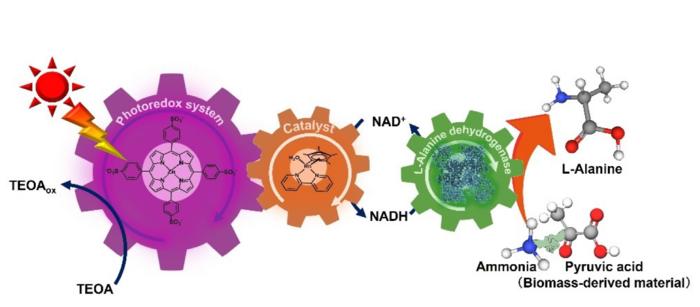
Osaka Metropolitan University scientists have made significant strides in the field of sustainable materials, particularly in the synthesis of biodegradable nylon precursors from biomass-derived compounds. This breakthrough is especially relevant as the world grapples with the growing concern of plastic pollution and the environmental impact of traditional petroleum-based plastics. As biodegradable plastics gain traction as a viable alternative, the insights from the research team led by Professor Yutaka Amao are timely and critical.
The research stems from a previous investigation that reported methods for producing raw materials for biodegradable plastics derived from biomass. The team had already demonstrated the feasibility of creating a polyester-type biodegradable plastic using L-lactic acid, a biobased compound. This time, their aim was to explore new horizons by synthesizing nylon precursors, a class of materials known for their elasticity and durability, which are typically synthesized from non-renewable fossil fuels.
The innovative approach taken by Professor Amao’s team involves artificial photosynthesis technology, which has been revolutionized by incorporating L-alanine dehydrogenase as a biocatalyst. This biocatalyst is pivotal in the process, as it combines ammonia with pyruvate—an important biochemical intermediate—resulting in the synthesis of L-alanine. By enriching this process with a photoredox system that includes a dye and a catalyst, the researchers effectively harness sunlight for the conversion of raw materials.
The production of L-alanine serves as a significant step towards developing biodegradable nylon. Unlike conventional nylon production methods, which rely heavily on petroleum derivatives, this novel synthesis pathway leverages solar energy and biomass—a renewable resource. Such an approach not only minimizes the dependence on fossil fuels but also aligns perfectly with global sustainability goals.
With the successful synthesis of the nylon precursor poly-L-alanine using solar energy, Professor Amao expresses optimism for the future of environmentally friendly plastics. He envisions a sustainable manufacturing process that could potentially reduce the environmental impact of plastic materials. By utilizing ammonia sourced from biomass compounds in the artificial photosynthesis process, the study marks a critical leap towards integrating green chemistry into plastic production.
The findings from this research have been published in the prestigious journal Sustainable Energy & Fuels, garnering attention within the scientific community. The potential applications of biodegradable nylon are vast, from textiles to packaging materials, suggesting a future where such innovations could significantly reduce the burden of plastic waste on the environment.
In recent years, biodegradable plastics have emerged as a trending solution in the fight against plastic pollution. Some of these materials degrade naturally, diminishing the long-lasting ecological footprint of conventional plastics. The synthesis of nylon-type biodegradable materials is an exciting innovation that addresses one of the largest components of plastic waste—nylon products.
As a result, this new research provides not only a technological advancement but also a crucial step towards achieving a circular economy in plastics. By establishing methods that rely on renewable resources, researchers can contribute to decreasing the volume of plastics that end up in landfills and oceans. With industries and consumers increasingly leaning towards sustainable practices, such findings seem more relevant than ever.
The implications of such research extend into various sectors, including packaging, automotive, and consumer goods. Each of these industries has a significant amount of waste attributed to traditional plastic products. The introduction of alternatives that maintain their functional properties while being biodegradable could catalyze a transformative shift in manufacturing practices.
Moreover, the process of artificial photosynthesis opens doors beyond the production of biodegradable nylon. The techniques developed can be adapted for synthesizing other valuable biocatalysts and compounds that can further aid in establishing sustainable practices across diverse chemical sectors. As researchers continue to develop and refine these processes, the topic of biobased materials is poised to gain even more traction.
This study serves as a commendation of interdisciplinary research, merging elements of chemistry, biology, and environmental science. The collaborative efforts in research foster the possibility of creating materials that not only meet consumer demands but also resonate with growing environmental consciousness among the public.
Moreover, the significance of this research is underscored by its potential to inspire future studies. With environmental sustainability at the forefront of global agendas, emerging scientists can follow in the footsteps of teams like Amao’s to further explore the capabilities of renewable resources in synthetic chemistry and materials science.
In summary, the advancements in biodegradable nylon precursor synthesis characterized by this research represent a watershed moment in the shift toward sustainable materials. This approach could ultimately lead us on a path where modern conveniences and ecological responsibility harmoniously coexist, aligning well with the principles of sustainable development.
The interplay between innovative research and practical application is vital, particularly as consumers and industries seek solutions to the pervasive problem of plastic waste. As more institutions commit to similar trajectories of research development, the combined efforts can collectively pave the way for a greener future.
Subject of Research: Synthesis of Biodegradable Nylon Precursors
Article Title: A photo/biocatalytic system for visible-light driven L-alanine production from ammonia and pyruvate
News Publication Date: 12-Nov-2024
Web References: DOI: 10.1039/D4SE01215A
References: None
Image Credits: Credit: Osaka Metropolitan University
Keywords
Biodegradable plastics, nylon synthesis, artificial photosynthesis, L-alanine production, environmental sustainability, renewable resources, biomass-derived compounds, sustainable materials, solar energy, chemical manufacturing, green chemistry.
Tags: artificial photosynthesisbiocatalysisbiodegradable nylonbiomass-derived compoundsenzyme catalysisgreen chemistryL-alanine productionplastic pollution solutionsrenewable resourcessolar-driven synthesissustainable energy applicationssustainable materials





